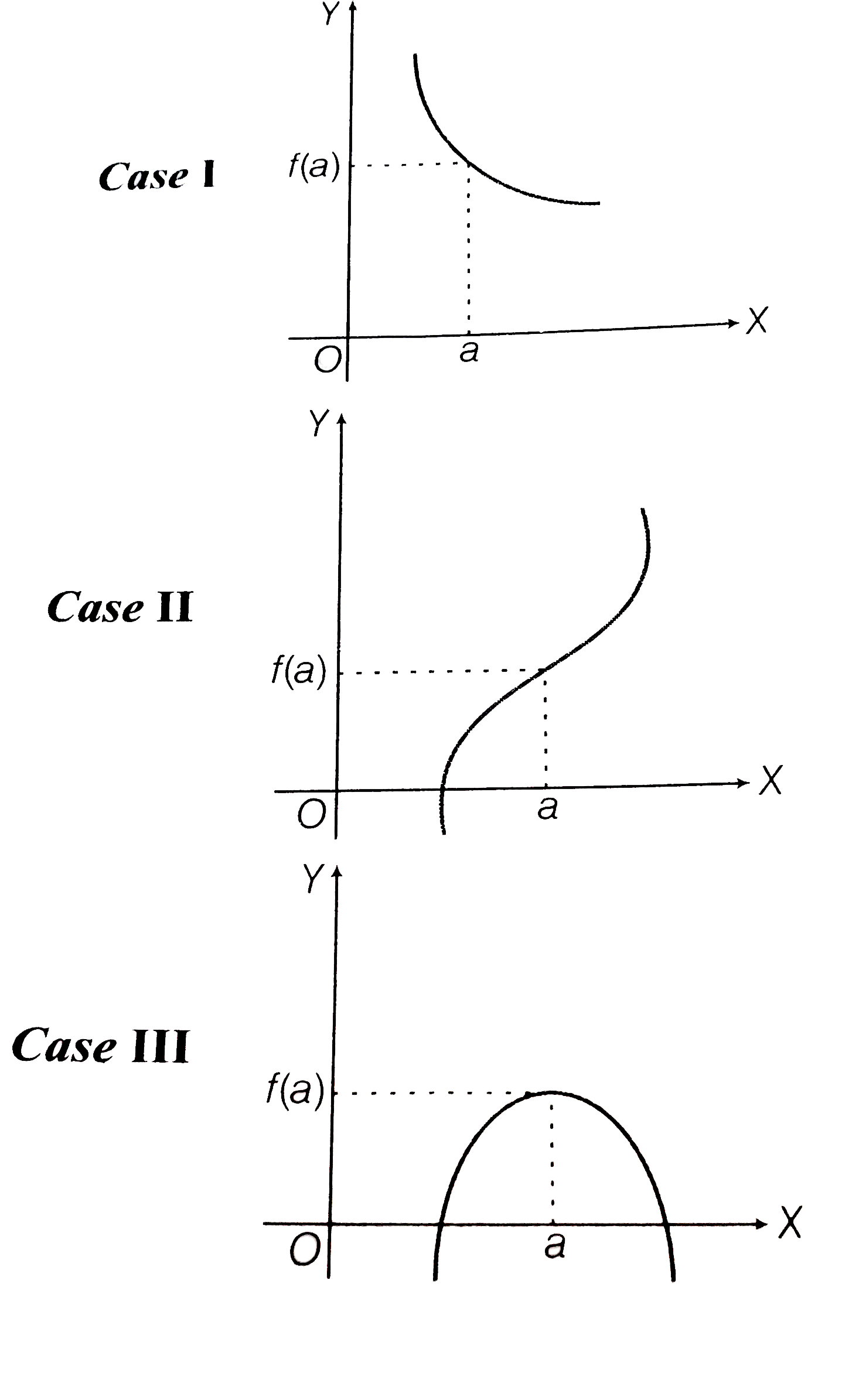Given that the derivative f'(a) exists. Indicate which of the following statements(s) is/are always true?
a. f'(a)=limh→af(h)−f(a)h−a
b. f'(a)=limh→0f(a)−f(a−h)h
c. f'(a)=limt→0f(a+2t)−f(a)t
d. f'(a)=limt→0f(a+2t)−t(a+t)2tSolution in Punjabi
f'(a)=limh→af(h)−f(a)h−a
f'(a)=limh→0f(a)−f(a−h)h
f'(a)=limt→0f(a+2t)−f(a)t
f'(a)=limt→0f(a+2t)−t(a+t)2t
The correct Answer is:A, C, D
Step by step video & image solution for Given that the derivative f'(a) exists. Indicate which of the following statements(s) is/are always true?a. f'(a)=lim_(htoa)(f(h)-f(a))/(h-a)b. f'(a)=lim_(hto0)(f(a)-f(a-h))/hc. f'(a)=lim_(t to0)(f(a+2t)-f(a))/td. f'(a)=lim_(t to0)(f(a+2t)-t(a+t))/(2t) by Maths experts to help you in doubts & scoring excellent marks in Class 12 exams.
Updated on:21/07/2023Topper's Solved these Questions
- LIMITSBOOK - ARIHANT MATHSCHAPTER - LIMITSEXERCISE - SOLVED EXAMPLES
1 Video
- LIMITSBOOK - ARIHANT MATHSCHAPTER - LIMITSEXERCISE - Exercise (Single Option Correct Type Questions)
38 Videos
- INVERSE TRIGONOMETRIC FUNCTIONSBOOK - ARIHANT MATHSCHAPTER - INVERSE TRIGONOMETRIC FUNCTIONSEXERCISE - Exercise (Questions Asked In Previous 13 Years Exam)
8 Videos
- LOGARITHM AND THEIR PROPERTIESBOOK - ARIHANT MATHSCHAPTER - LOGARITHM AND THEIR PROPERTIESEXERCISE - Exercise (Questions Asked In Previous 13 Years Exam)
4 Videos
Similar Questions
To evaluate limx→a[f(x)], we must analyse the f(x) in right hand neighbourhood as well as in left hand neighbourhood of x=a. E.g. In case of continuous function, we may come across followign cases.


Iff(a) is an integer, the limit will exist in Case III and Case IV but not in Case I and Case II. If f(a) is not an integer, the limit exists in all the cases. ltbgt If f'(1)=−3 and limx→1[f(x)−12] does not exist, (where [.] denotes the greatest integer function), then
View Solutionlimx→0sin(πcos2(tan(sinx)))x2 is equal to
View SolutionIf α=3sin−1(611andβ=3cos−1(49), where the inverse trigonometric functions take only the principal values, then the correct options (s) is (are)
View SolutionIn Which quadrant Point (−2,−3) will be lie.
View SolutionLet f(t)=|[cost,t,1],[2sint,t,2t],[sint,t,t]| then find lim_(t->0) f(t)/t^2.
View SolutionIf f is a positive function such that f(x+T)=f(x)(T>0),AA x in R, then lim_(n rarr oo)n((f(x+T)+2f(x+2T)+......+nf(x+nT))/(f(x+T)+4f(x+4T)+......+n^(2)f(x+n^(2)T)))=
View SolutionLeft hand derivative and right hand derivative of a function f(x) at a point x=a are defined as
f'(a−)=–––lim(h→0+)f(a)−f(a−h)h
=limh→0+f(a+h)−f(a)h
andf'(a+)=limh→0+f(a+h)−f(a)h
=limh→0+f(a)−f(a+h)h
=limh→0+f(a)−f(x)a−x respectively.
Let f be a twice differentiable function. We also know that derivative of a even function is odd function and derivative of an odd function is even function.
If f is even function, which of the following is right hand derivative of f' at x=a?
View SolutionLeft hand derivative and right hand derivative of a function f(x) at a point x=a are defined as
f'(a−)=limh→0+f(a)−f(a−h)h
=limh→0+f(a+h)−f(a)h
andf'(a+)=limh→0+f(a+h)−f(a)h
=limh→0+f(a)−f(a+h)h
=limh→0+f(a)−f(x)a−x respectively.
Let f be a twice differentiable function. We also know that derivative of a even function is odd function and derivative of an odd function is even function.
The statement limh→0f(−x)−f(−x−h)h=limh→0f(x)−f(x−h)−h implies that for all x∈R,
View Solutionयदि f(x)=1x तो सिद्ध कीजिए कि limh→0f(x+h)−f(x)h=−1x2
View Solutionlimh→0f(a+h)−f(a)h=
View Solutionlim_(h rarr 0) (f(a+h)-f(a))/(h) is
View Solutionlim_(h rarr 0) (f(a-h)-f(a))/(-h) is
View SolutionLet f(t)=∣∣ ∣∣costt12sintt2tsinttt∣∣ ∣∣ then find limt→0f(t)t2.
View Solutionकिसी बिंदु. x = a पर एक फलन f(x) का बायाँ और दायां अवकलज क्रमशः f(a−)=limh→0+(f(a)−h)h=limh→0+f(a+h)−f(a)h और f(a+)=limh→0+f(a+h)−f(a)h=limh→0−f(a)−f(a−h)h=limx→a+f(a)−f(x)a−x द्वारा परिभषित किया जाता है।
माना की f दो बार अवकलनीय फलन है। हम जानते है की सैम फलन का अवकलज विषम फलन तथा विषम फलन का सैम फलन होता है।
उपरोक्त जानकारी के आधार पर , निम्न प्रश्नों के उत्तर दीजिए :
यदि f विषम है तो निम्न में से कौन - सा पर x = -a का बायाँ अवकलज है -
View Solutionकिसी बिंदु. x = a पर एक फलन f(x) का बायाँ और दायां अवकलज क्रमशः f(a−)=limh→0+(f(a)−h)h=limh→0+f(a+h)−f(a)h और f(a+)=limh→0+f(a+h)−f(a)h=limh→0−f(a)−f(a−h)h=limx→a+f(a)−f(x)a−x द्वारा परिभषित किया जाता है।
माना की f दो बार अवकलनीय फलन है। हम जानते है की सैम फलन का अवकलज विषम फलन तथा विषम फलन का सैम फलन होता है।
उपरोक्त जानकारी के आधार पर , निम्न प्रश्नों के उत्तर दीजिए :
यदि f सम है , तो निम्न में से कौन-सा x = a पर f' का दायां अवकलज है -
View Solution